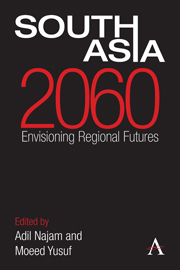Book contents
- Frontmatter
- Contents
- Acknowledgments
- List of Abbreviations
- Introduction: Imagining South Asian Futures
- Section I South Asia as a Region
- Section II State Relations
- Section III Development
- Chapter 16 South Asian Economy in 2060
- Chapter 17 Economic Futures: Challenges Ahead
- Chapter 18 South Asia in the Asian Economy: Struggling to Overcome History
- Chapter 19 Globalization and South Asia
- Chapter 20 Trade Relations: Some Predictions and Lessons
- Chapter 21 Urban Policy for Environmental Quality and Well-Being
- Chapter 22 Urban Futures, Urban Challenges
- Chapter 23 Water Security: Risks and Responses
- Chapter 24 Agriculture and Food Security
- Chapter 25 Meeting Electric Power Demand in South Asia
- Chapter 26 E-South Asia: A Social Science Fiction
- Section IV Human Well-Being
- About the Authors
- Bibliography
- Index
Chapter 21 - Urban Policy for Environmental Quality and Well-Being
from Section III - Development
Published online by Cambridge University Press: 05 September 2013
- Frontmatter
- Contents
- Acknowledgments
- List of Abbreviations
- Introduction: Imagining South Asian Futures
- Section I South Asia as a Region
- Section II State Relations
- Section III Development
- Chapter 16 South Asian Economy in 2060
- Chapter 17 Economic Futures: Challenges Ahead
- Chapter 18 South Asia in the Asian Economy: Struggling to Overcome History
- Chapter 19 Globalization and South Asia
- Chapter 20 Trade Relations: Some Predictions and Lessons
- Chapter 21 Urban Policy for Environmental Quality and Well-Being
- Chapter 22 Urban Futures, Urban Challenges
- Chapter 23 Water Security: Risks and Responses
- Chapter 24 Agriculture and Food Security
- Chapter 25 Meeting Electric Power Demand in South Asia
- Chapter 26 E-South Asia: A Social Science Fiction
- Section IV Human Well-Being
- About the Authors
- Bibliography
- Index
Summary
Introduction: Population, Human Development and Environment
South Asia has made significant progress since independence from colonial rule in the late 1940s. In the face of dire predictions made in the 1960s and 1970s about food security, for example, cereal production has increased about threefold since that time (FAO 2003). Life expectancy has increased from a mere 39 years in 1950 to about 66 years, which is just three years below the global average (UN Population Division 2010). Despite these vast strides, significant challenges remain.
Seventy percent of the region's inhabitants live on less than $2, and about a third on less than $1.25, daily, on a purchasing power parity (PPP) basis (World Bank 2013). A fifth of South Asia's population is undernourished, and a third of its children below five years are underweight. South Asia performs worse than Sub-Saharan Africa in the latter respect, and accounts for more than half of the world's undernourished children. Mortality rates for infants below five years have reduced by over 40 percent relative to 1990, but are still considerably higher than the United Nations (UN) Millennium Development Goal (MDG) target for 2015. While the region has made considerable progress with regard to safe drinking water, it has the worst record with regard to sanitation. Sixty percent of its people lack access to even what the UN deems “improved,” but hardly adequate, sanitation, with significant implications for the spread of various infectious diseases (United Nations 2012).
- Type
- Chapter
- Information
- South Asia 2060Envisioning Regional Futures, pp. 160 - 168Publisher: Anthem PressPrint publication year: 2013



